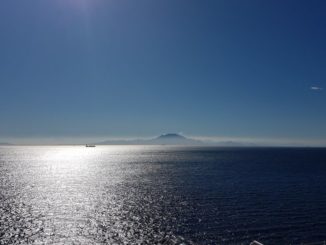At first glance, it would seem unlikely to drive all the way from Carlisle to Gibraltar just to take a photograph of a filling station. Albeit an interesting one which was, as we saw last time on Nostalgia Album, to be the scene of the shooting of IRA terrorists McCann and O’Farrell 36 years later.
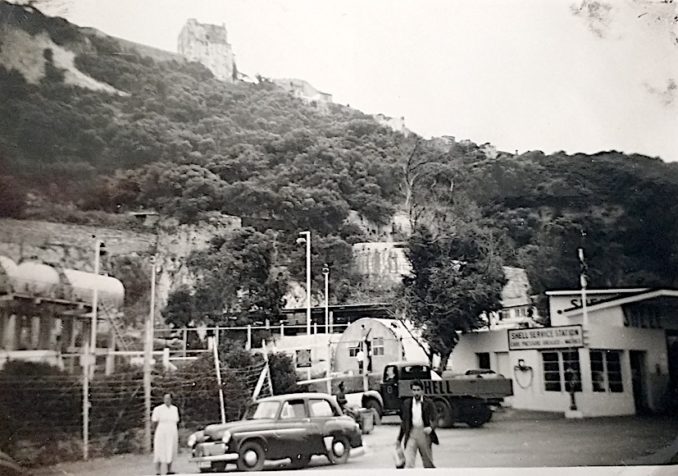
© Always Worth Saying 2022, Going Postal
Another point of interest is the Moorish castle at the top of the escapement behind the Shell facility, a medieval structure part of which housed Gibraltar prisoners until 2010.
Camp Bay
Away from filling stations and old castles, an obvious attraction in early 1950s Gibraltar would be Catalan Bay but the next photograph is easily identifiable as Camp Bay, which is recognisable to this day but is covered in concrete. According to recent reviews, the newer set-up is well regarded and can be used for free. Close to the town, it is within walking distance of South Barracks, Buena Vista Barracks and the Royal Navy Hospital. The old photo was taken below Parsons Lodge Battery where Street View allows a contemporary 360-degree view while standing on Camp Bay Road.
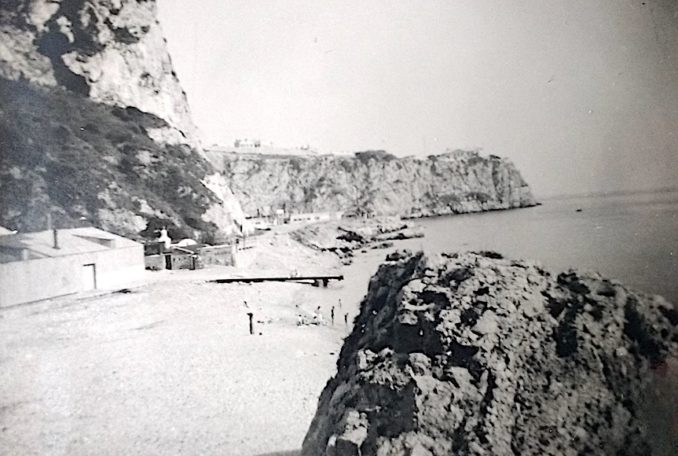
© Always Worth Saying 2022, Going Postal
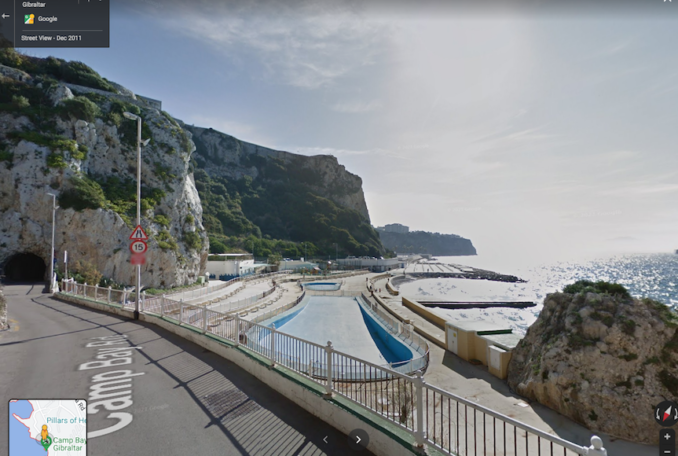
© Google Street View 2022, Google
The concealed bay was previously a stone quarry worked by convicts. Called El Quarry in Andalusian, it was also put to use by Spanish smugglers. An impossibly narrow tunnel, characteristic of the isthmus and requiring a 15 mph speed limit, heads in the direction of Europa Point. On the other side of the tunnel is the more famous Nuffield or Europa Pool.
It was over the Nuffield, from high up on the cliffs at the lower end of Southern Road, that a burning Land Rover containing half a ton of explosives, a baddie and Timothy Dalton’s James Bond (fortunately equipped with a parachute) was propelled during the opening sequence of 1987’s Living Daylights.
As OO7 landed on the deck of a super yacht and into the arms of a bored sunbathing model, so our next photograph shows some more sunbathers, this time on the beach at Camp Bay. Also revealed is the reason for the long trip to Gib. The clue was in Picture 1, with the female figure near to the black car being my father’s Aunt Lil. In our album, the caption reads ‘Moorish Castle, Lil and Hillman Gib’. The writing beneath Picture 4 states, ‘Happy Reunion’
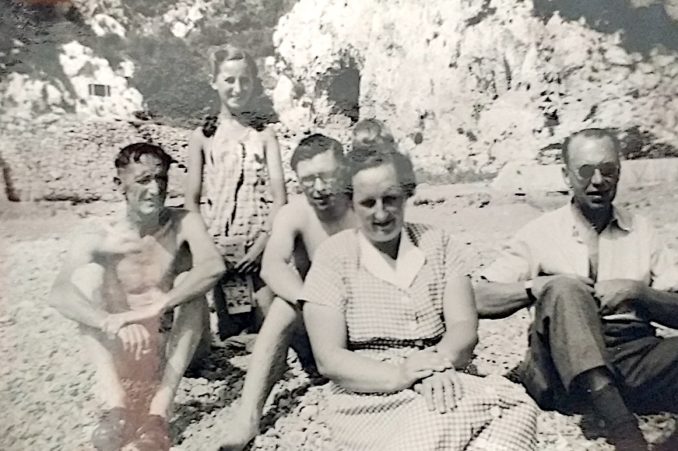
© Always Worth Saying 2022, Going Postal
You’ll recall that my grandfather’s sister, Martha Lillian, her husband Rob and daughter Anne were in Malta just after the war. Rob worked in the naval dockyards. As per a previous episode, they left Valetta in 1949 and by 1952 were stationed in Gibraltar hence my father and grandparents setting off from Carlisle in the valiant Ford 8 on the long trip south.
Left to right sit, Rob, now aged 46, still with jet black hair but looking painfully thin and with a cigarette between the first and second fingers of his right hand. Then my father’s cousin, Anne, kneeling upright and by now in her thirteenth year. Next is my father in his glasses, 21, and then brother and sister, Lil (54) and Elihu (46). Behind, one of the Camp Bay road tunnels sits at the back of a shingle beach made up of quarry spoil. My grandmother, Edith, was presumably taking the photo.
In the next photograph, we see ‘Mam the contortionist’. Immortalised either with the help of a volunteer lying behind her or by demonstrating a dexterity known of the Duchess of Windsor and suspected of Meghan Markle.

© Always Worth Saying 2022, Going Postal
Next time the shutter clattered, mam appeared thin and unwell. A sickly woman to start with, and looking older than her 42 years, I don’t suppose the bone-rattling boily hot 1,800-mile trip on rough roads in an old car aided her constitution. Advance warning. The Worth-Sayings are not long-lived.
The Barbary Apes
No visit to the Rock is complete without sight of a Barbary Ape. This one looks as though it’s been captured for posterity from the bay road while perched on a wall next to the corrugated shed to the left of Picture 2.
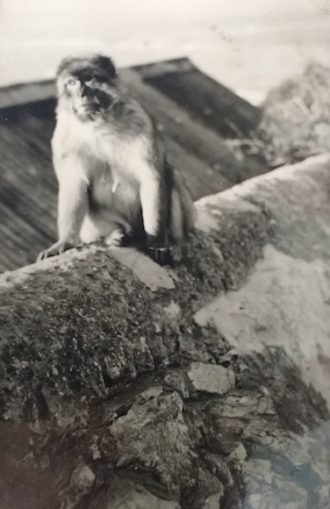
© Always Worth Saying 2022, Going Postal
Also called the Barbary macaque, these apes are the only wild monkey population on the European continent. These days, about 300 animals live in five troops about the Upper Rock area. Which is just as well as legend insists if the apes ever leave, so will ourselves and the Union Flag. Legend also claims the macaques can enter the Rock via a secret passage that leads all the way from Morocco. And that during World War II, with numbers dropping as low as seven, Winston Churchill himself led a secret mission to Algeria to bag a few more.
In better times a ‘Keeper of the Apes’ was tasked to catalogue the animals and keep an up-to-date register. They were allocated names and permitted a food allowance of £4 a month. The Army being the Army, that was a total of £4 for all 300 of them. For obvious reasons, they were named after senior officers. Their births, deaths and matings were announced in the Gibraltar Chronicle.
Alameda Botanic Gardens
The next photograph isn’t from our Nostalgia Album but from a loose packet in the family deed box. As you can see, Lil and Anne seem welland areenjoying sunshine. Although nothing is written on the back of the print, given the rocky outcrop behind the ladies I would say the location is still on Gibraltar and at the Botanic Gardens. If so, the windows of the slab-sided white building behind and to the right of my great aunt and my first cousin one time removed may well belong to the Rock Hotel.
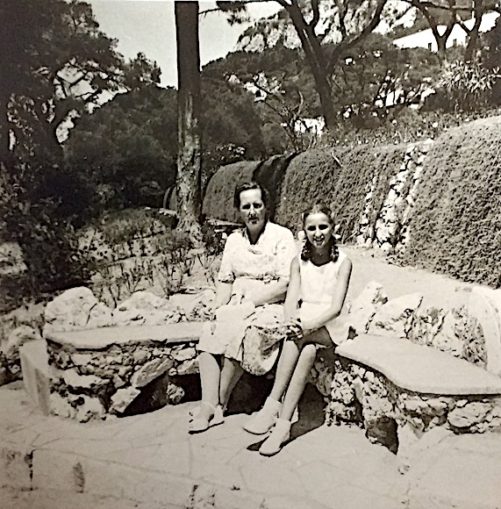
© Always Worth Saying 2022, Going Postal
The gardens, or the Alameda, cover 15 acres and were opened in 1816 by General Sir George Don, the then governor of the Crown Territory. General Don thought gardens would be helpful to the soldiers stationed in the nearby fortress as they would provide a recreational area protected from the extreme heat of the sun.
The northern entrance is guarded by a monument to George Elliot. Not that George Elliot. Fans of Middlemarch and Felix Holt, the Radical will be disappointed to find a column and four howitzers placed in honour of George Augustus Elliot. Elevated to the 1st Baron Heathfield as a hero of the Severn Years War, he was commander of the Gibraltar garrison during the Great Siege of 1779 to 1783.
In more recent times, the gardens have been restored, with a zoo (in these sensitive days titled a wildlife conservation park) added in 1994. Less woke was an original arch which straddled one of the pathways between Chinese hibiscus and bougainvillaea – made of whalebone.
As for the Rock Hotel, one man’s slab-sided utility is another’s Art Deco masterpiece. Built in 1932 by the 4th Marquis of Bute, the Rock Hotel is set in 9 acres of gardens. Only months prior to my family’s visit the building was damaged when RFA Bedenham exploded at the naval base.
Better times lay ahead. In 1962 Chruchill’s actress daughter, Sarah Millicent Hermoine, married Thomas Percy Henry Touchet-Jesson, 23rd Baron Audley MBE in a civil ceremony there. Later in the same year, Sean Connery and Diane Cilento honeymooned at the 104-room hotel after marrying in Gibraltar. I wonder if the happy couples had their wedding photos taken at the exact spot where Lil and Anne are seated? I bet they did.
Gibraltar Childhood
Sight of short sleeves, a short skirt, platts, white ankle socks and an excited smile leads one to wonder of Anne’s childhood. Plenty of social media sites share service families’ memories of overseas postings. I would particularly recommend Being a Boy in 1950s Gibraltar.
According to contributors, life was idyllic for the children but perhaps less so for mums billeted in often crumbling married quarters. For the youngsters, there were old tanks to play on. Old army store rooms and empty gun forts provided more entertainment as did caves to explore. In the summer, school finished at 1 pm allowing for long days of swimming and fishing in the bays.
Educational standards were high, with the eleven plus dividing children between grammar schools and a Dockyard and Technical school. According to the blog’s author,
Bishop Fitzgerald’s [school] sat on the edge of the town walls close to a cemetery which we were constantly told, held the bones of Admiral Nelson’s men. The school playground was on the roof and we ran wild and free under the Mediterranean sun, with the most stupendous views of the Navy yards and the great Royal Navy ships.
Lessons were taught by the feared Christian Brothers with the schooling provided being ominously described as ‘focused’. To the Brother’s credit, those who returned to England found themselves a couple of years ahead of their less fortunate contemporaries who had suffered more modern lessons.
Sink water was fresh, bath water was salt. Sea soap was sold in the shops. There were Navy Days and RAF Days, caves and candles and ghost stories, fiestas at La Linea and siestas closer to home. On Thursdays, school walked into the town for a church service. Bays were reached by running through tunnels while armed with picnics.
Days began and ended on verandas with panoramas; of the impressive docks, of sunsets and sun rises over the Med, of the North African coast across a strait teaming with gams of porpoise. Old regiments manned the garrison. As well as khaki and drill they brought with them sword dancing, cabers, bagpipes and kilts. On Army Days, the children ran and leapt and gorged on Scottish shortbread.
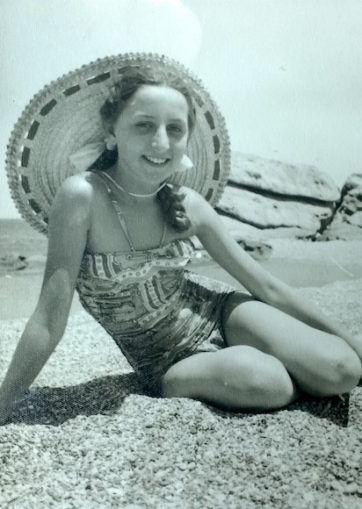
© Always Worth Saying 2022, Going Postal
Not surprisingly, Anne appears to have thrived and is seen a year later, in 1953 now 14, back on the beach, beaming. Would it last? Find out next time on Nostalgia Album!
Recommend Reading
On Being a Boy in 1950s Gibraltar
© Always Worth Saying 2022



